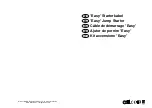
Version 1.00
3
INTRODUCTION
As with any piece of new gear, there is always a bit of new jargon to get to grips with. The RE32 is
no exception! What follows, therefore, is a short list of some of the terms you will come across
during the course of this manual.
GRID
This stands for GRaphic Interface Display and refers to the track display on the
external monitor.
PROJECT
This contains all your recordings, edited and positioned as required and shown
on the GRID. Think of it as a reel of multi-track tape if you like and the GRID as
an animated track sheet.
A PROJECT also contains autolocator memories, MIDI tempo maps, etc., and
these are all saved with the project. The SYSTEM settings are also saved with
the project and when a project is subsequently loaded, the whole system is
restored to exactly the status the project was saved in. For example, the tracks
selected for playback, editing and/or record, the sample rate, external timecode
selection, input routing, etc.. All these will be explained later.
Each connected machine actually has its own PROJECT containing audio tracks
on that machine but the RE32 assembles this information for display on the
monitor as a single ‘multi-track’ PROJECT.
NOW TIME
In the centre of the GRID are two vertical lines. The centre of these two lines is
known as the NOW TIME and the actual NOW time is shown in the display
above it (and on the LED timecode display). All work is done with referenced to
this NOW time. For example, to select a cue for editing, move it to the NOW
time and press SELECT Q. Marking IN times and OUT times and locate
memories is also done referenced to the NOW time.
CUE
This refers to a piece of audio from its start to its end in the GRID. In this
manual, a cue may be referred to as “a stereo cue” - this is actually two mono
cues across two (normally adjacent) tracks that make up a ‘stereo’ cue.
EDIT REGION
This refers to the area selected between the IN and the OUT points. A track (or
tracks) must be selected for editing and the edit region is highlighted green on
the external monitor.
IN TIME
This usually refers to the start of an edit. However, the IN TIME is used to set
auto punch-in and cycle times as well. It is marked by pressing the IN key
located above the jog wheel.
OUT TIME
This usually refers to the end of an edit although it is also used to set auto
punch-out and cycle times. It is marked by pressing the OUT key located above
the jog wheel.
SYNC POINT
This is a special marker you can place within an edit region or cue for sync
purposes.
MARK POINT
This is a special marker intended for Biphase synchronisation. It can be set to
define a sync point between audio and film (usually a cross before the first
frame).
Summary of Contents for RE32
Page 10: ...Page ix ...














































